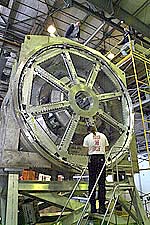Press release, CERN, translation from Space Daily - Dikla Oren

Direct link to this page: https://www.hayadan.org.il/cern030204.html
The first unit of the CMS (Compact Muon Solenoid) superconducting magnets makes its way to CERN.
The first of the five units that make up the CMS superconducting magnet array left where it was assembled on January 21 on its way to CERN. The CMS is one of the experiments that will be conducted at the LHC accelerator (Large Hadron Collider). The accelerator is currently under construction at CERN.
The facility will reach its destination after a ten-day journey. One of the CMS's ambitious goals is to provide information on the elusive Higgs boson. The Higgs is an elementary particle, which is related to the mechanism that gives masses to the various particles. The theoretical models predict its existence, but no one has discovered it directly yet.
The CMS will analyze the products of collisions between proton beams. It will reconstruct the trajectories of the particles and measure their energy. The superconducting magnet, which contains the heart of the experiment, produces a very strong magnetic field. It is essential for the identification of the particles, which are formed as a result of the collisions.
The orbits of the charged particles are deflected as a result of the magnetic field in different ways depending on the valve and their charge. Thus, looking at the particle trajectories tells us a lot about their identity.
In order for the particle trajectories to be deflected in a way that we can measure, a magnetic field whose strength is equal to the energy of the particles coming out of the collision is needed. Since at the LHC very high energy particle beams will be created and collided (on a very small scale these particles reproduce the state of the universe in its first moments), a huge magnetic field is needed.
The superconducting magnet is the result of an international collaboration between different research institutes. The participants are the INFN (National Institute for Nuclear Physics), CERN, the CEA (the body in charge of atomic energy), the Eth-Z (the Technion in Zurich) and in collaboration with "Enceladus Superconductors". This company was entrusted with the construction of the five units that make up the magnets, as well as 1,500 square meters for this construction.
Besides the huge magnetic field they create, the magnets must be huge in size. This is so that they can contain all the detectors, which are necessary for conducting accurate measurements. If so, the CMS has an internal diameter of 6.3 meters and a length of 12.5 meters. It produces a magnetic field with a strength of about 4 Tesla (about 80,000 times stronger than the Earth's field). Upon completion, the CMS superconducting magnet will achieve an impressive record: it will break the world record for energy stored in a magnet with an energy of 2.6 gigajoules.
Another feature of this facility is that it must only operate at very low temperatures. For this reason, the cables in which an electric current will flow will be made of superconductors.
Thanks to the conductivity the electric current needed to create the electric field can flow through several cables with a diameter of about a millimeter. If conductors had not been used, it would have been necessary to use such thick cables that the construction of the entire structure would not have been possible at all.
The impressive size of the superconducting coil, which is the "heart of the magnet", meant that it would be necessary to build it in several parts. This is so that it can be transferred from the place of production to the CERN laboratories.
"A lot of work optimizing the designs led us to divide the coil into five parts, 2.5 meters long and weighing 45 tons. Each part will be built and sent to CERN, where the work of assembling them will begin," says Pascual Fabricator, a researcher at the INFN in Geneva.
In fact, the INFN is responsible for designing and building what is known as the "cold mass", meaning the mechanical structures that will be cooled to -268 degrees Celsius (4.2 degrees Kelvin).
The construction of the superconducting magnet for CMS required the development of innovative technologies. "Because a very high electric current flows in the superconducting magnet, the magnetic field that is created is so strong and the device is so huge, strong electromagnetic forces are created inside the coil, which may cause changes in the device and stop its operation."
The standard solution to this problem is to add a mechanical mounting structure to accommodate the coil. In the present case it was not enough.
"Furthermore, to avoid even the slightest deformation, which would cause the cables to lose their superconducting properties, the reinforcement was inserted directly into the cables. This is an innovative solution that requires incredible technical capabilities."
"However, at this stage twisting the cables in the right direction became a very difficult task. If so, the need arose for the development of a fully automatic and very sophisticated cable winding system, which would allow the cables to be wound with high geometric precision," concludes Pascual Fabricator.
Link to the original article on Space Daily
Physics expert
https://www.hayadan.org.il/BuildaGate4/general2/data_card.php?Cat=~~~745311162~~~95&SiteName=hayadan
